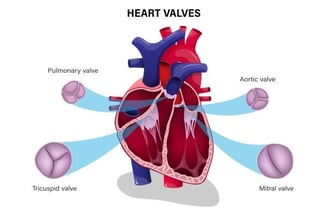

Heart Valves
Your heart valves are like doors between your heart chambers. They open and close to allow blood to flow through. They also keep your blood from moving in the wrong direction.
Atrioventricular valves
The atrioventricular (AV) valves open between your upper and lower heart chambers. They include:
Tricuspid valve: Door between your right atrium and right ventricle.
Mitral valve: Door between your left atrium and left ventricle.
Semilunar valves
Semilunar (SL) valves open when blood flows out of your ventricles. They include:
Aortic valve: Opens when blood flows out of your left ventricle to your aorta (artery that carries oxygen-rich blood to your body).
Pulmonary Valve: Opens when blood flows from your right ventricle to your Pulmonary arteries (the only arteries that carry oxygen-poor blood to your lungs).
The heart has four main valves that regulate blood flow through the chambers and prevent backflow. These valves ensure that blood moves in the correct direction and is pumped efficiently throughout the body. Here's an overview of each heart valve:
1. Tricuspid Valve
Location: Between the right atrium and the right ventricle.
Structure: The tricuspid valve has three leaflets or cusps, which is why it is called "tricuspid."
Function: It prevents the backflow of blood from the right ventricle into the right atrium during ventricular contraction (systole). Blood flows from the right atrium through the tricuspid valve into the right ventricle.
2. Pulmonary Valve
Location: Between the right ventricle and the pulmonary artery.
Structure: The pulmonary valve has three semilunar cusps.
Function: It prevents the backflow of blood from the pulmonary artery into the right ventricle after the ventricle contracts and pumps blood into the pulmonary circulation (to the lungs).
3. Bicuspid (Mitral) Valve
Location: Between the left atrium and the left ventricle.
Structure: The bicuspid valve has two leaflets. It is also called the mitral valve.
Function: It prevents the backflow of blood from the left ventricle into the left atrium when the left ventricle contracts. Blood flows from the left atrium through the mitral valve into the left ventricle.
4. Aortic Valve
Location: Between the left ventricle and the aorta.
Structure: The aortic valve has three semilunar cusps.
Function: It prevents the backflow of blood from the aorta into the left ventricle after the ventricle pumps blood into the aorta, which distributes oxygenated blood to the rest of the body.
Summary of Heart Valve Functions:
Tricuspid Valve: Prevents backflow from the right ventricle to the right atrium.
Pulmonary Valve: Prevents backflow from the pulmonary artery to the right ventricle.
Bicuspid (Mitral) Valve: Prevents backflow from the left ventricle to the left atrium.
Aortic Valve: Prevents backflow from the aorta to the left ventricle.
Valve Operation (Systole vs. Diastole):
Systole: The heart contracts. The ventricles pump blood into the arteries, and the atrioventricular (AV) valves close to prevent backflow. This phase corresponds to the highest blood pressure (systolic pressure).
Diastole: The heart relaxes. The ventricles fill with blood from the atria, and the semilunar valves close to prevent blood from flowing back into the ventricles. This phase corresponds to the lowest blood pressure (diastolic pressure).
Systole is the contraction phase, while diastole is the relaxation phase.
Key points:
Heart valves prevent blood from flowing backward
Heart valves ensure blood flows in one direction, maintaining efficient blood circulation.
Heart valves are critical for maintaining heart function and overall health
Anatomy Useful Links
